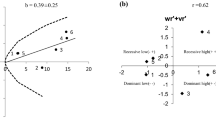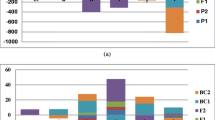Abstract
Basic information on genetics and inheritance of quantitative characters, which is necessary to develop future breeding programme, is not widely studied in pigeonpea. Hence, present study was conducted among 5 generations in four pigeonpea crosses to know significance of additive-dominance model, gene action involved in inheritance of quantitative characters, heritability and genetic advance. “Scaling” and “joint scaling test” was significant for most characters indicating that additive-dominance model alone is not enough to explain the inheritance of a character. Though additive variance was more, dominance variance also played important role for most of the traits. Positive and negative alleles were found to be distributed between parents. Additive gene effect (d) was significant for pods per plant and seeds per pod whereas dominance gene effect (h) was more predominant among pod yield and seed yield. Dominance × Dominance inter-allelic interactions (l) was more important than Additive × Additive type (i) for most of the traits studied which could be exploited by selecting individuals based on their performance in recurrent selection. Complementary gene action was observed among many traits with few exhibiting duplicate gene action. Heritability and genetic advance was high indicating the effectiveness of selection. Since dominance effects is also present along with additive effects selection could be practised in later generations to identify high yielding genotypes.
Similar content being viewed by others
References
Abney M, McPeek MS, Ober C (2001) Broad and narrow heritabilities of quantitative traits in a founder population. Am J Hum Genet 68:1302–1307
Amand PC, Wehner TC (2001) Generation mean analysis of leaf and stem resistance to gummy stem blight in cucumber. J Am Soc Hortic Sci 126(1):95–99
Bartual R, Lacasa A, Marsal J, Tello J (1993) Epistasis in the resistance of pepper to phytophthora stem blight (Phytophthora capsici L.) and its significance in the prediction of double cross performances. Euphytica 72:149–152
Basavarajaiah D, Byre Gowda M, Lohithaswa HC, Kulkarni RS (2000) Assessment of pigeonpea germplasm and isolation of elite genotypes for Karnataka. Crop Res 20(3):444–448
Cavalli LL (1952) An analysis of linkage in quantitative inheritance. In: Reive ECR and Waddington CH (eds) HMSO, London, pp 135–144
DAC (Department of Agriculture and Cooperation) 2011. http://eands.dacnet.nic.in/At_Glance_2010/4.14(A).xls
Deb AC, Khaleque MA (2009) Nature of gene action of some quantitative traits in chickpea (Cicer arietinum). World J Agric Sci 5(3):361–368
Dias RC, Pico B, Espinos A, Nuez F (2004) Resistance to melon vine decline derived from Cucumis melo spp. agrestis: genetic analysis of root structures and root response. Plant Breed 123:66–72
Ganapathy KN, Byregowda M, Venkatesha SC, Ramachandra R, Gnanesh BN, Girish G (2009) Identification of AFLP marker linked to sterility mosaic disease in pigeonpea Cajanus cajan (L.) Millsp. Int J Integr biol 7(3):145–149
Ganapathy KN, Gnanesh BN, Byregowda M, Venkatesha SC, Sunil SG, Channamallikarjuna V (2010) AFLP analysis in Pigeonpea [Cajanus cajan (L.) Millsp.] revealed close relationship of cultivated genotypes with some of its wild relatives. Genet Resour Crop Evol 58(6):837–847
Gill KS (1980) Recent concepts in breeding methodology of self-pollinated crops. In Gill KS (ed) Breeding methodologies for pulse crops
Gupta AK, Singh IS, Bajpai GC (1996) Generation mean analysis for flowering and maturity in four pigeonpea crosses in Pantnagar, Uttar Pradesh India. Int Chickpea pigeonpea Newst 3:73–74
Hansen T, Wagner G (2001) Epistasis and the mutation load: a measurement theoretical approach. Genetics 158:477
Hayman BI (1958) The separation of epistatic from additive and dominance variation in generation means. Heredity 12:371–390
Hayman BI, Mather K (1955) The description of genetic interaction in continuous variation. Biometrics 11:69–82
Hooda JS, Tomar YS, Singh VP (2003) Analysis of gene effects in two pigeonpea crosses. Legume res 26(4):276–278
IIPR (Indian Institute of Pulse Research) 23 May 2011. www.iipr.res.in/pigeonpea.html. Accessed 27 July 2011
Imielinski M, Belta C (2008) Exploiting the pathway structure of metabolism to reveal high-order epistasis. BMC Syst Biol 2:40
Jain HK (1975) Development of high yielding varieties of pulses: perspective, possibilities and experimental approaches. p 177–185 in proceedings, international workshop on grain legumes. ICRISAT, 13–16 Jan 1975, Hyderabad, India
Joarder OI, Eunus AM, Rahman S (1977) Analysis of F3 generation of Brassica campestris L. Acta Agron 26:354–363
Johnson HW, Robinson HE, Comstock RE (1955) Estimates of genetic and environmental variability in soybean. Agron J 47:314–318
Kearsey MJ, Pooni HS (1996) The genetic analysis of quantitative traits. Chapman and Hall, London
Kumar B, Patra NM (2010) Genetic analysis of capsule and its associated economic traits in Opium poppy (Papaver somniferum L.). J Hered 101(5):657–660
Lindsey MF, Lonnquist JM, Gardner CO (1962) Estimate of genetic variance in open pollinated varieties of corn. Crop Sci 2:105–108
Marchini J, Donnelly P, Cardon L (2005) Genome-wide strategies for detecting multiple loci that influence complex diseases. Nat Genet 37:413–417
Mather K (1949) Biometrical genetics. Dover publications Inc, New York
Mather K, Jinks JL (1971) Biometrical genetics. Chapman and Hall ltd, London
Mather K, Jinks JL (1982) Biometrical genetics: the study of continuous variation, 3rd edn. Chapman and Hall, London
Mathews KL, Malosetti M, Chapman S, McIntyre L, Reynolds M, Shorter R, van Eeuwijk F (2008) Multi-environment QTL mixed models for drought stress adaptation in wheat. Theor Appl Genet 117:1077–1091
Milus EA, Line RF (1986) Gene action for inheritance of durable, high-temperature, adult-plant resistance to stripe rust in wheat. Phytopathol 76:435–441
Moll RH, Robinson HF, Cockerham CO (1960) Genetic variability in advanced generation of crosses two open-pollinated varieties of corn. Agron J 52:171–173
Nadarajan N, Gunasekaran LM (2005) Quantative Genetics and biometrical techniques in plant breeding. Kalyani publishers, New Delhi, India
Nahar SMN (1997) Genetic study of economically important characters and construction of selection index in sugarcane. Ph.D thesis Rajshahi University, Bangladesh
Panse VG (1957) Genetics of quantitative characters in relation to plant breeding. Indian J Genet 17:318–335
Purcell S, Neale B, Todd-Brown K, Thomas L, Ferreira M et al (2007) PLINK: a tool set for whole-genome association and population-based linkage analyses. Am J Hum Genet 81:559–575
Reynolds M, Manes Y, Izanloo A, Langridge P (2009) Phenotyping approaches for physiological breeding and gene discovery in wheat. Ann Appl Biol 155:309–320
Robinson HF, Comstock RE, Harney PH (1949) Estimates of heritability and degree in corn. Agron J 41:353–359
Robinson HF, Comstock RE, Harney PH (1955) Genetic variance in open pollinated varieties of corn. Genetics 40:45–60
Sameer KCV, Sreelakshmi CH, Shivani D, Suresh M (2009) Gene effects for yield contributing characters in pigeonpea (Cajanus cajan L. Millsp) by generation mean analysis. J Res ANGRAU 37(3–4):71–76
Saxena KB (2008) Genetic improvement of pigeonpea–a review. Trop Plant Biol 1:159–178
Saxena KB, Singh L, Gupta MD (1990) Variation for natural outcrossing in pigeonpea. Euphytica 46:143–148
Saxena KB, Kumar RV, Sultana R (2010) Quality nutrition through pigeonpea–a review. Health 11:1335–1344
Shahid MA (1996) Genomic composition, gene action and genotype–interaction in hexaploid wheat (Triticum aestivum L.) dissertation, Rajshahi University, Bangladesh
Sharma D, Green JM (1975) Perspective of pigeonpea and ICRISAT’s breeding program. In proceedings, international workshop on grain legumes p 19–29. ICRISAT, Hyderabad, India, 13–16 Jan 1975
Shashikumar KT, Pitchaimuthu M, Rawal RD (2010) Generation mean analysis of resistance to downy mildew in adult muskmelon plants. Euphytica 173:121–127
Sidhu PS, Sandhu TS (1980) The role of genetical studies in developing new cultivars of pigeonpea for non traditional areas of North India. In proceedings of international workshop on pigeonpea vol 2. p 117–128, ICRISAT, Hyderabad, India, 15–19 Dec 1980
Singh AP, Singh UP, Singh RM, Rajni R (2003) Relative efficiencies of four population improvement schemes in pigeonpea [Cajanus cajan (L.) Millsp.]. Crop Res 25(2):305-311
Swaminathan MS (1973) Basic research needed for further improvement of pulse crops in South east Asia. In Milner MM (ed) Nutritional improvement of food legumes by breeding. Protein Advisory Group, United Nations, p 61–68
Varshney RK, Penmetsa RV, Dutta S, Kulwal PL, Saxena RK, Datta S, Sharma TR, Rosen B, Carrasquilla-Garcia N, Farmer AD, Dubey A, Saxena KB, Gao J, Fakrudin B, Singh MN, Singh BP, Wanjari KB, Yuan M, Srivastava RK, Kilian A, Upadhyaya HD, Mallikarjuna N, Town CD, Bruening GE, He G, May GD, McCombie R, Jackson SA, Singh NK, Cook DR (2010) Pigeonpea genomics initiative (PGI): an international effort to improve crop productivity of pigeonpea (Cajanus cajan L.). Mol Breed 26:393–408
Wang Z, Liu T, Lin Z, Hegarty J, Koltun WA, Wu R (2010) A general model for multilocus epistatic interactions in case-control studies. PLoS ONE 5(8):e11384. doi:10.1371/journal.pone.0011384
Williams W (1960) Heterosis and genetics of complex characters. Heredity 15:327–328
Wu R (1996) Detecting epistatic genetic variance with a clonally replicated design: models for low vs high-order nonallelic interaction. Theor Appl Genet 93:102–109
Acknowledgments
Authors wish to express their gratitude to the Government of India (Rashtriya krishi Vikas Yojana, RKVY)) for supporting this project. Authors also thankful to “anonymous” reviewers for the valuable suggestions and comments to improve the manuscript.
Author information
Authors and Affiliations
Corresponding author
Rights and permissions
About this article
Cite this article
Ajay, B.C., Gnanesh, B.N., Ganapathy, K.N. et al. Genetic analysis of yield and quantitative traits in pigeonpea (Cajanus cajan L. Millsp.). Euphytica 186, 705–714 (2012). https://doi.org/10.1007/s10681-011-0556-1
Received:
Accepted:
Published:
Issue Date:
DOI: https://doi.org/10.1007/s10681-011-0556-1




